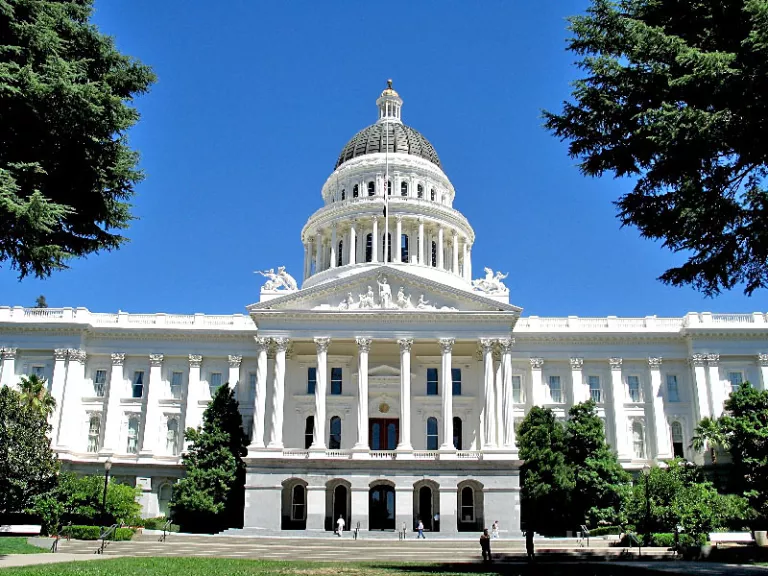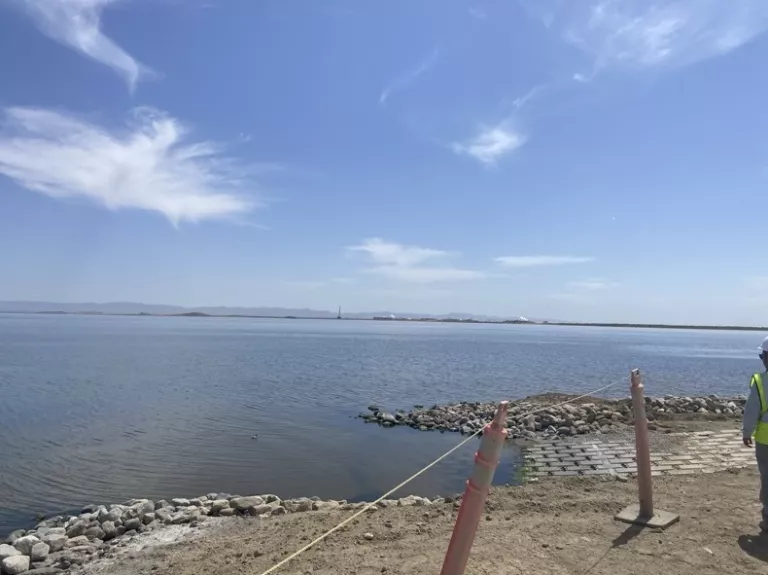
Climate Updates in the First Half of California’s Legislative Session
Digging Into the State's Annual Report on the Salton Sea
Major News on California’s 30x30 Progress

It's a busy time in Sacramento, and as always, we need your support to fight the climate crisis. On June 2nd, we reached the house of origin deadline, where bills had to be voted out of the house they were introduced in (ABs in the Assembly, SBs in the Senate).
Sierra Club California has taken positions on nearly 200 bills this year. The California Legislative Committee voted to support 147 of them and oppose 48. We're actively tracking an additional 300 bills. Out of the 200 bills we took a position on, 140 are still in progress. Some bills we support include AB 421 (Bryan), which reforms California's referendum process to prevent corporations from hindering our progress in protecting communities, and SB 252 (Gonzalez), which stops two state pension funds from investing in major fossil fuel companies. You can find our Priority Bill list from the Legislative Committee here.
We're also working hard to defend the climate budget passed in recent years. This budget has provided vital investments in combating and adapting to the severe impacts of the climate crisis. Unfortunately, the Governor has proposed cutting several programs, including those that incentivize transitioning low-income homes away from gas, safeguard against sea-level rise, and restore the Salton Sea. We must ensure that these programs receive the necessary funding before the June 15 constitutional budget deadline. Furthermore, we're urging the legislature to allocate more funds to public transit agencies to support their operations and reduce vehicle emissions.
We're also actively pushing back on the process and substance of the Governor's infrastructure package, which threatens important environmental laws and the protections they offer to California's communities and ecosystems. Both the Assembly and Senate recently held hearings to review the package, and you can watch them here, here, and here (click Senate Natural Resources and Water Committee).
So, how can you contribute to this fight? Call your legislators and let them know that you support the specific pro-environment bills highlighted in our Priority Bill list. We're also hosting an in-district lobbying webinar on Thursday, June 29th at 4pm PT to ensure everyone is well-informed about our priority bills before the legislature's summer recess. Please register here!
Together, let's take action and make a difference in this critical time.
Digging Into the State's Annual Report on the Salton Sea
By Alyssa Orozco and Erin Woolley

May was an important month for the Salton Sea, as state agency staff, community members and organizations, and environmental groups gathered in Imperial, California to discuss last year’s progress on the Salton Sea Management Program.
The Salton Sea, California's largest inland lake, is rapidly receding due to reduced runoff and increased evaporation caused by climate change. This poses complex challenges for both the ecosystem and nearby communities. The exposed lakebed, known as playa, causes health issues like asthma in local communities. Additionally, the shrinking sea concentrates pollutants and diminishes habitat for migratory birds on the Pacific Flyway.
The California Natural Resources Agency (CNRA) is leading efforts to address the shrinking Salton Sea through dust suppression and habitat restoration projects. The State Water Resources Control Board has mandated CNRA to implement 30,000 acres of projects by 2028. Each year, CNRA releases an annual report outlining its progress and conservation plans. Recently, the State Water Board conducted a meeting in the Salton Sea region to hear from local residents and assess CNRA's restoration work on-site. This meeting provided an opportunity for direct community engagement and firsthand review of CNRA's efforts.
Additionally, the Salton Sea Management Program team hosted a project tour highlighting the progress at the Species Conservation Habitat (SCH) Project, located along the New River at the southern end of the Salton Sea. This project encompasses 4,100 acres of aquatic restoration that will cover harmful dust from the exposed lakebed and develop critical habitat through the creation of a network of ponds with islands and areas of varying water depths. Fresh water from the New River is mixed with high saline water pumped from the Salton Sea to create a less saline brackish water that fills the 4,100 acres of constructed wetlands that have been designed to provide habitat for migratory birds. Operations and maintenance of the project is estimated to cost between $2-5 million annually.
In the first five years of the SSMP, CNRA has lagged far behind its projected restoration and dust suppression goals. The absence of agreements with landowners to access lands surrounding the Salton Sea remains a major barrier to timely project implementation. In 2022, CNRA completed a mere 290 acres of projects. However, completion of the SCH project, along with other projects planned over the next two years, would go a long way towards making up for the growing backlog and ensuring the overall project goals are met by 2028.
Over the course of the two-day meeting, the State Water Board heard CNRA staff report on the progress achieved in 2022. A series of panels made up of scientists, community members, stakeholders, and other agency staff spoke on a variety of issues, including declining Colorado River water supplies, air quality and public health, and community needs and perspectives on the Salton Sea. Ahead of the meeting, over 1,376 Sierra Club California supporters sent comments to the State Water Board asking for greater clarity as to project completion, accounting for water demands of future projects, and timely implementation of projects that incorporate public access and amenities. During the meeting, additional supporters, community members, and stakeholders gave direct feedback to the State Water Board about the urgently needed progress at the Salton Sea.
After two days of discussion and testimony by passionate individuals sharing their field expertise and knowledge regarding the state of the Salton Sea, two things became abundantly clear - how much is at stake and how much people care not only for the Salton Sea ecosystem but the surrounding region and its communities. If projects are done right, the Salton Sea presents an opportunity for the environment, wildlife, and local residents to benefit. However, that will require increased transparency and accessibility of ongoing processes and greater coordination and engagement with community members as future projects get off the ground to ensure community perspectives and values are driving investments. There must also be significant financial investments and commitments to ensure future projects include community amenities and access, and that projects that are constructed have the resources to be operated and maintained to provide benefits long-term.
Join our work to protect the Salton Sea - sign up to stay up to date on efforts to protect the Salton Sea.
Major News on California’s 30x30 Progress

30x30 is a global movement with the goal of preserving 30% of lands and waters by 2030, and the broader goal of protecting "half earth", or 50% of lands and water by 2050. With the initial benchmark just 6.5 years away, it is critical for California to continue its significant conservation progress in order to mitigate the impacts of the climate crisis and preserve our state’s land and water for future generations.
Last month, California Natural Resources Agency (CNRA) released two progress reports on 30x30: the Outdoors for All Draft Strategy which focuses on equitable outdoor access, and the Pathways to 30x30 Progress Report which encompasses all 30x30 objectives and corresponds to CNRA’s 2022 Pathways to 30x30. These new reports detail the state’s conservation priorities and highlight work that is already underway. This is a unique opportunity for advocates to get involved with existing programs, identify what is missing from these strategies, and hold the state accountable to its 30x30 goals.
The Outdoors for All Draft Strategy outlines six priorities that aim to increase greenspaces and access to nature across all communities in California. It delineates five clear actions that CNRA will take towards implementing this strategy, while calling for collaboration on the widespread implementation and the bulk of the proposed strategy. CNRA is accepting public comments on this draft strategy through July 10th.
According to the Pathways to 30x30 Progress report, there has been a total of 631,000 acres added to the conserved land totals in California, resulting in a 0.4% increase in land and a 0.2% increase for coastal waters conserved last year. These increases in tandem with the myriad of projects and programs highlighted in the report put us "on track to reach our goal" (pg 15).
While this is great news for 30x30, and we are excited that the state is moving these priorities forward, we still need to advocate for stronger implementation and long term funding of these efforts. We also need to continue advancing local, state, and federal legislative and administrative policy changes that reduce barriers to achieving 30x30, halt immediate and systemic threats to lands and waters, and advance equity goals in conservation efforts.
We can’t truly reach our preservation goals if threats to equitable access, biodiversity, and a liveable climate remain unchecked. We need your help to draw attention to policies and practices that are at odds with 30x30 goals, and advocate for solutions. If you are interested in getting involved with this work, please click here.
Follow Us:
  |
Thank you for being a part of our work! Consider making a monthly donation. You may securely donate online or by sending a check to Sierra Club California at 909 12th Street, Suite 202, Sacramento, CA 95814.
